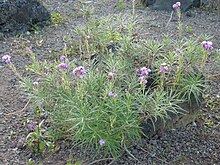Erysimum caboverdeanum
Erysimum caboverdeanum is a plant species that belongs to the Brassicaceae family, the cabbage or mustard family. It is found only in the Fogo island, Cape Verde.
| Erysimum caboverdeanum | |
|---|---|

| |
| Erysimum caboverdeanum at the botanical gardens in Las Palmas, Canary Islands | |
| Scientific classification | |
| Kingdom: | |
| (unranked): | |
| (unranked): | |
| (unranked): | |
| Order: | |
| Family: | |
| Genus: | |
| Species: | E. caboverdeanum
|
| Binomial name | |
| Erysimum caboveredanum | |
| Synonyms | |
|
Matthiola caboverdeana A.Chev. | |
It was named for the first time by the French botanist Auguste Jean Baptiste Chevalier in 1935.[1] Caboverdeanum (or the original caboverdeana) is a Latin word that means "Cape Verdean" or "from Cape Verde".
Synonym
changeChevalier named, in 1935, this species as Matthiola caboverdeana; this name now is a synonym because Sunding changed it to the present name, Erysimum caboverdeanum.[2]
Common names
changeIt is locally known as crabo bravo ("wild carnation")[3] and alecrim branco ("white rosemary").[1]
Description
changeErysimum caboverdeanum is a biennial small bush, up to 60 cm (24 in) high; its stems are woody and they stand upright. The narrow leaves are about 4 cm (1.6 in) long and 0.2 cm (0.08 in) wide and their margins are finely toothed.[1][4]
The flowers, which are white or lilac coloured, are in groups (inflorescences) at the end of the stems.[1] The fruits are very narrow and stand upright.[4]
Where it grows
changeErysimum caboverdeanum is an endemic species of the Cape Verdean island of Fogo on the volcano Pico do Fogo. It is common in soils with a recent volcanic origin at an altitude between 1,600 and 2,300 m (5,249 and 7,546 ft); it is found on the slopes of the volcano and in the Chã das Caldeiras, the plain in the volcanic crater.[1][4]
Uses
changeThe species is used for traditional medicinal purposes[4] mainly as an infusion.[3]
It is possible to use it as an ornamental plant, even in places like central Europe.[1]
References
change- ↑ 1.0 1.1 1.2 1.3 1.4 1.5 Auguste Chevalier (1935). Les îles du Cap Vert : géographie, biogéographie, agriculture. Flore de l'archipel (in French). Paris: Muséum national d'histoire naturelle, laboratoire d'agronomie coloniale. p. 992. Available on at TelaBotanica.
- ↑ "Erysimum caboverdeanum (Chev.) Sunding". The Plant List. Retrieved 21 August 2013.[permanent dead link]
- ↑ 3.0 3.1 (in Portuguese) Alda Roque Gomes, Teresa Vasconcelos et M. Helena Guimarães de Almeida, « Plantas na medicina tradicional de Cabo Verde », p. 7 in Plantas Medicinais e Fitoterapêuticas nos Trópicos, IICT /CCCM, 29, 30 et 31 octobre 2008 [1] Archived 2017-03-29 at the Wayback Machine
- ↑ 4.0 4.1 4.2 4.3 Isildo Gomes; et al. (2003). Plantas endémicas e árvores indígenas das ilhas do Cabo Verde (in Portuguese). Cape Verde: Instituto Nacional de Investigação e Desenvolvimento Agrário and Deutsche Gesellschaft für Technische Zusammenarbeitand.
Other websites
change- Catalogue of Life: Erysimum caboverdeanum (Chev.) Sunding Archived 2016-03-03 at the Wayback Machine, retrieved on 21 August 2013
- Erysimum caboverdeanum at NCBI, retrieved on 21 August 2013